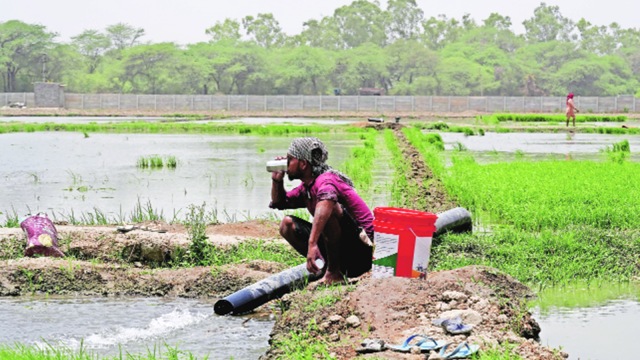Water levels dip in Punjab, Rajasthan dams compared to normal storage: CWC
The CWC monitors the northern region's 10 reservoirs, collectively possessing a total live storage capacity of 19.663 billion cubic meters (BCM).
 Paddy sowing has already begun in Haryana.
Paddy sowing has already begun in Haryana.
Ahead of the rains in the northern region, the dams in Punjab and Rajasthan have recorded less water than the normal storage during this time, while in Himachal Pradesh it’s a little surplus than the normal, according to a Central Water Commission (CWC) report.
The northern region includes Himachal Pradesh, Punjab, and Rajasthan.
The CWC monitors the northern region’s 10 reservoirs, collectively possessing a total live storage capacity of 19.663 billion cubic meters (BCM).
As of the reservoir storage monitoring conducted on June 6, the cumulative live storage in these reservoirs stood at 5.888 BCM, equivalent to 30% of their total live storage capacity.
Comparatively the storage levels were higher at 39% in the corresponding period during the previous year, while the normal storage during this period typically reaches 31% of the live storage capacity of these reservoirs.
Consequently, the current year’s storage levels indicate a decrease both in comparison to the previous year and the normal storage levels during the corresponding period, underscoring potential concerns about water availability.
According to the CWC report, the current reservoir level in Punjab’s Thein Dam is at 506.77 metres against 527.91 metres full reservoir level (FRL). The dam has 0.964 BCM current live storage against the live capacity of 2.344 BCM which is 41% of the live capacity at FRL against 52% of live capacity at FRL last year and 51% of the normal storage by this time.
Live storage means the status of water currently in the dam, while the current live storage means the volume of water stored between the full reservoir level and the minimum pool level. It is also called useful storage as it assumes the supply of water for a specific period to meet the water demand. Live storage capacity is below the FRL. It is the volume of water between the outlet works and the spillway crest. Outlet works serve to regulate water impounded by a dam, while spillway is a structure used to provide the controlled release of water downstream from a dam. The spillway crest is the highest elevation of the floor of the spillway.
In Rajasthan there are six dams, including Mahi Bajaj Sagar, Jhakam, Rana Pratap Sagar, Bilaspur, Jawai Dam, and Jaisamand. Here too all the dams are showing a low water storage than the normal and last year, barring Rana Pratap Sagar which has live storage more than than the normal but less than the last year.
According to the CWC report, Jaisamand dam is witnessing 24% live storage against the 57% live storage last year and 36% of the normal live storage by this time. Bilaspur dam is having 29% storage this year against 59% last year and 41% of the normal storage, Jhakam dam is having 17% of the live storage against 25% last year and 26% of the normal storage, Jawai dam is having 12% of the live storage against 21% last year and 13% of the normal storage. Mahi Bajaj dam is having 30% of the current storage against 31% last year and 31% of the normal storage.
Rana Pratap Sagar is the only dam in Rajasthan which has 39% of the live storage against 35% of the normal storage, but it is quite less than last year’s live storage which was 77% during this time.
Meanwhile, in Himachal Pradesh, Bhakra dam, Pong dam and Kol dam witnessed a little surplus than the normal storage but less than last year’s storage except in Bhakra dam.
Bhakra dam is showing 30% of the live storage against 24% last year and 28% of the normal live storage, Pong dam is witnessing 25% of the live storage against 38% last year and 26% of the normal storage, while Kol dam has 48% of the live storage against 52% last year and 31% of the normal storage.












